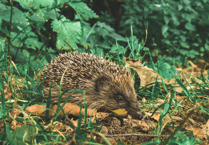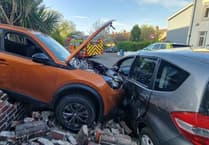Did you know that, according to UK Government statistics, you are more likely to be involved in a fatal road accident on a rural road than on an urban one?
Given the Isle of Man is predominantly rural and has no speed limit on many of its roads, the problem is a real one at any time of year.
But now that we’re mid-winter when bad weather and poor visibility are at their worst, a timely reminder about road safety seems appropriate - whether you are an animal owner or not.
All road users have an obligation to be visible.
Please think again if you are the driver who doesn’t think they need to put their headlights on whenever they drive at this time of year.
Even in the middle of the day, the low sun can make it very difficult to see oncoming traffic.
Think again if you are the cyclist, clad in black lycra, who thinks a flashing red light at the rear of you bike is sufficient (it isn’t!)
Think again if you are the rider of a horse who thinks it’s OK not to wear any high viz because you mount is grey or white (that really is an equestrian myth). Horse riders should try to avoid using roads altogether during peak traffic times - and if you can’t use hand signals because you need to keep control of the reins, then you should acknowledge a courteous passing driver with a smile and a nod of the head.
And if you are a dog owner (particularly if this is your first winter as an owner) are you keeping yourself and your companion as safe as possible when walking on, or near, our roads?
There is a wide range of, often very fashionable, high viz clothing and accessories available now for both owners and dogs alike - available at local retailers and online.
Going back to vehicle drivers, it is understandable that a delay in your journey can be frustrating - not least if you’re stuck behind a horse in front of you walking at five miles per hour. But please be patient.
Horses are prey animals and no matter how well-trained and calm they normally are, they can still be unpredictable and become frightened by something they perceive to be a threat (a new road sign, for example, or a plastic bag in a hedge).
Please don’t accelerate rapidly once you’ve overtaken the horse, or rev your engine while you are waiting.
And, just as with cyclists, please don’t curse horse riders who are riding two abreast - this is legal (although shouldn’t be simply because the riders want to have a good chat) and it helps to make the ’obstruction’ shorter, and therefore quicker to overtake when it’s safe to do so.
There are lots of other road safety tips that even experienced drivers should re-familiarise themselves with:
-When driving on winding roads slow down ahead of the bend and not once you enter it, and anticipate another road user being just out of you line of sight.
-Hidden dips (which make it difficult to see oncoming traffic) are a feature of Manx roads - do you know what the warning sign for a hidden dip looks like?
-Fresh manure on the road could indicate that horses, cattle or sheep are just around the next corner.
-If you see a bird or wild animal in the road, sound your horn (some drivers don’t know where their horn is located because, understandably, they use it so infrequently) but only swerve to avoid the animal if it’s safe to do so.
-Mud on the road may mean that there’s a tractor up ahead. Again, this can be frustrating because it’s moving at a slow pace, but usually a tractor isn’t travelling too far and it won’t be long before it pulls in.
If you do decide to overtake, make absolutely sure the road ahead is clear and consider any junctions that other road users may pull out from.
Please also bear in mind that, due to their size, tractors may swing out to the right before turning left.
We inevitably need to share our roads, so let’s do this with respects for other users - both humans and animals.




